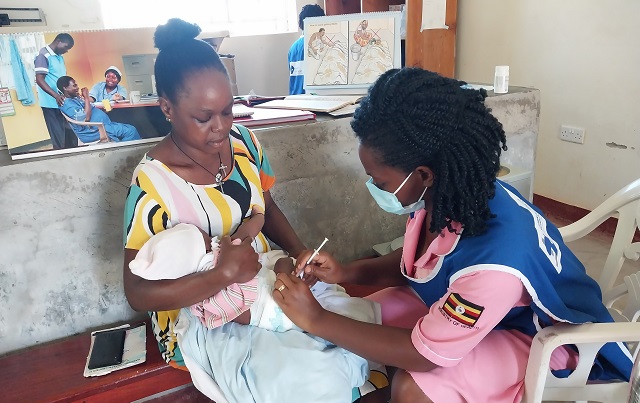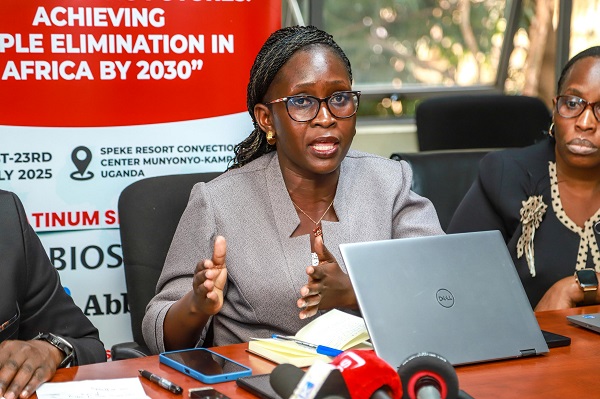
New theme as Uganda conference pushes triple strategy against HIV, Syphilis, Hepatitis B
Kampala, Uganda | RONALD MUSOKE | To mark its hosting of the Triple Elimination Conference in Africa scheduled for July 21-23 in Kampala, Uganda is rolling out a bold and unprecedented strategy to eliminate mother-to-child transmission of three infectious diseases: HIV, syphilis, and hepatitis B.
This integrated approach marks a significant shift in public health strategy, aiming to leverage existing structures, scale-up prevention tools, and save thousands of infants from preventable illnesses and deaths.
According to the Ministry of Health, the three diseases–HIV, syphilis and hepatitis B– share similar transmission routes and disproportionately affect women and infants, particularly in low- and middle-income countries.
“The government is now capitalising on the overlaps in prevention and treatment to integrate services under one umbrella—ensuring no mother or child falls through the cracks,” said Dr Robert Mutumba, the Assistant Commissioner Health Services in the STD/AIDS Control Division, at the Ministry of Health, during a press conference on July 14. “We also see a number of prevention tools being similar.”
Dr Mutumba explained that the elimination of the vertical transmission of the three infections is aligned to the global agenda where the World Health Organisation (WHO) is leading efforts to ensure that countries like Uganda are supported to eliminate the three diseases.
The plan is ambitious: 90% of newborns vaccinated with the hepatitis B birth dose, 95% of pregnant women tested for all three infections, and universal treatment for those who test positive.
Dr. Mutumba emphasized the importance of newborn babies getting vaccinated against hepatitis B. “Some of you think that the best gift that you can give to your child is either a cake or some other (tangible) gift but, for us, we believe that the best gift you can give to your baby in addition to the other gifts are the vaccines.”
He said it is also important to ensure that the pregnant women who have been diagnosed with Hepatitis B get treatment. “Just like we have been linking them to HIV treatment is the same way we want to ensure that after we have diagnosed them with any of these diseases, we use the same structures to link them to treatment,” said Dr. Mutumba.
Syphilis’s quiet comeback
Once nearly eliminated in many parts of the world, syphilis is seeing a resurgence—especially in Africa. In Uganda, about 6% of adults have ever had syphilis, and there is an active infection prevalence of around 2%. The disease is more common among women and even more so among those living with HIV.
Dr. Mutumba emphasised that syphilis is not only preventable and curable but also poses serious risks during pregnancy if left untreated—leading to stillbirths, premature births, or congenital syphilis in newborns. “We’ve made great progress with HIV. Now it’s time to bring syphilis and hepatitis B up to the same level of attention and urgency,” he said.
Spotlight on Hepatitis B: the overlooked threat
According to the National Viral Hepatitis Prevention and Control Strategic Plan 2023-2028, although Uganda has strategies for the prevention of transmission of viral hepatitis (childhood vaccination against hepatitis B, safe injection practices, screening of all donor blood against transfusion-transmitted infections), there is still a large cohort of people who are infected with viral hepatitis, thanks to the high prevalence rates in the country.
The burden of hepatitis B in Uganda is significant, with a national adult prevalence of 4.1%, rising to 4.7% among HIV-positive individuals. “Every few seconds, viral hepatitis claims a life somewhere in the world, and in Uganda, the burden, particularly from hepatitis B, is significant,” Dr. Rony Bahatungire, the Acting Commissioner for Clinical Services at the Ministry of Health, said at the same press conference.
Since 2002, Uganda has made major progress in the fight against viral hepatitis, through the introduction of the hepatitis B vaccine as part of the pentavalent vaccine in the national immunisation programme. But senior officials in the Ministry of Health say gaps remain in adult coverage and newborn protection.
Since 2015, Uganda has also implemented targeted screening and treatment campaigns for hepatitis B, reaching over 4 million adults with screening and vaccination services. With this, more than 260,000 individuals have been diagnosed with hepatitis B and have been successfully linked into care, which is a very big and significant achievement for the country.
In 2022, the birth dose vaccine was also introduced in select facilities to prevent mother-to-child transmission of hepatitis. And now, thanks to support from Gavi, a national rollout is scheduled for August, this year. This will mark a significant step toward the triple elimination goals that have been set up as an agenda for this country, said Dr. Miriam Ajambo, a senior pediatrician at the Ministry of Health.
Dr Bahatungire noted that Uganda’s strategy is looking at the integration of hepatitis B prevention and care into maternal and child health platforms, alongside existing services for HIV and syphilis.
“We’re making it easier for pregnant women to access comprehensive care in one go,” he said. “That means improved maternal and newborn outcomes and a more efficient health system.”

“Pregnant women and their newborns can now access comprehensive, integrated care that addresses all the three conditions; that is viral hepatitis, HIV/AIDS, as well as syphilis,” he said, adding that: “The strategy has also laid the groundwork for piloting the hepatitis B birth dose vaccine, and scaling up care for hepatitis B-positive pregnant women and their infants.
Today, a range of essential services, including free viral load testing, liver function tests, and treatment are available at designated public and private health facilities across the country. In addition, the country has also made bold moves towards sustainability, launching local production of first-line hepatitis B medicines and planning for domestic manufacture of hepatitis C treatments. These steps reflect a shift towards self-reliance in an era of unpredictable donor funding.
“Our commitment is strengthened by the National Viral Hepatitis Prevention and Control Strategic Plan of 2023-2028, which sets bold targets, one of which is reducing the new infections by 50%, expanding access to diagnosis and treatment, and ensuring that we build robust health systems to achieve viral hepatitis elimination,” said Dr. Bahatungire.
A Shift towards integration and prevention
Uganda’s triple elimination agenda is anchored in a national framework that consolidates decades of disease-specific efforts into one strategic front. It builds on global targets set by WHO in 2021, which called on countries to eliminate mother-to-child transmission of these infections by 2030.
The Ministry of Health has responded with a robust national plan that emphasises early antenatal testing, timely treatment, and widespread immunisation. Pregnant women are now offered integrated services for all three conditions at once—HIV, syphilis, and hepatitis B—eliminating the need for separate visits and ensuring timely intervention.
But while progress is evident, challenges persist, including gaps in linkage to care, limited external funding for community engagement, and incomplete population-level data for viral hepatitis.
Sister Doreen Ruth Akuno, the focal point for hepatitis at the Uganda National Expanded Programme on Immunisation (UNEPI) notes that the financial resources earmarked for managing hepatitis B have not been as forthcoming when compared to, for instance, HIV/AIDS.
“Hepatitis has not been fully adopted by partners to support as HIV and other diseases. And so you find that annually we only have US$3 million (Approx. 11 billion) budget for the hepatitis programme, and out of that Shs 8.5 billion is allocated for commodities like drugs at National Medical Stores.”
However, she says, the situation will change now that the Ministry of Health has begun working with Gavi, the Vaccine Alliance, to procure vaccines for hepatitis B. Sister Akuno said the first batch of about 200,000 vials for the birth dose will arrive in the country in August, this year.
“That will now help us to cascade the birth dose to the entire country and facilities…It is a mandate that every newborn baby born, whether in the facility or outside the facility, should be vaccinated within the first 24 hours with this vaccine,” she said.
Maternal health as the frontline
Central to Uganda’s strategy is the focus on maternal health. The Ministry of Health reports that over 90% of Ugandan women attend at least one antenatal care (ANC) visit, but only 40% attend within the first trimester, when early testing is most effective.
Dr. Robert Mutumba, the Assistant Commissioner for Health Services in the ministry’s STD/AIDS Control Division, says this is where much of the battle is. “Our fight starts with early antenatal care. If we can test every pregnant woman early for HIV, syphilis, and hepatitis B, we can break the chain of vertical transmission,” he said. “Our target is to test over 95% of all pregnant women and initiate immediate treatment where necessary.”
He says antiretroviral therapy (ART) is now available for HIV and hepatitis B, while syphilis remains fully curable if detected early. The ministry is also scaling up home-based early infant diagnosis and follow-up care for babies born to infected mothers.
Elimination of PMTC close but not there yet
Uganda has made progress in reducing mother-to-child transmission of HIV. According to UNAIDS data shared by Jotham Mubangizi, the Strategic Information Adviser at the UN agency, the country has seen a 76% drop in vertical transmission between 2010 and 2024. In 2024 alone, there were 4,700 new infections among infants—still too many, but a marked decline from previous years.
“The biggest challenge now is during breastfeeding,” Mubangizi noted. “That’s where most new transmissions occur. We must support HIV-positive mothers to stay on treatment and suppress the virus.”
He also stressed the importance of engaging men and communities in the care journey. “Men are often left out, yet their support is crucial—financially, emotionally, and socially. We must bring them into the conversation.”
The Ministry is implementing re-testing protocols for pregnant women during labour and breastfeeding, alongside Pre-Exposure Prophylaxis (PrEP) for high-risk mothers. Testing kits that screen for both HIV and syphilis are already in widespread use.
“It will be a sin for a pregnant woman to miss an HIV test because then if she’s positive, she will transmit the virus to the unborn baby yet the current science is able to prevent that mother from transmitting any of these infections to her baby,” Dr. Mutumba said.
Funding, awareness, and stigma
Despite strong political will, Uganda’s triple elimination plan faces challenges like inadequate funding, low public awareness, and persistent stigma around sexually transmitted infections.
Kenneth Kabagambe, the Executive Director of the National Organization for People Living with Hepatitis B, says the Triple Elimination Conference in Kampala which will be held under the theme, “Unifying Actions: Achieving Triple Elimination in Africa by 2030,” is a key opportunity to forge a united, homegrown front. “With foreign aid declining, Africa must find its own solutions,” he said.
 The Independent Uganda: You get the Truth we Pay the Price
The Independent Uganda: You get the Truth we Pay the Price



